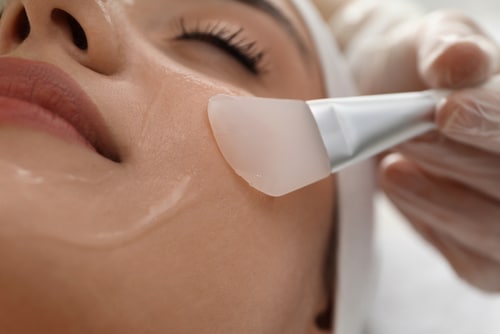If you are reading this blog, chances are you are in search of a cost-effective, reliable way to lighten and remove melasma, darkening of the skin, or other imperfections. Sun exposure, hormonal changes, and acne scars commonly cause this type of skin damage. Are chemical peels a good option to repair this type of damage? Yes! Read on to learn what, why, and how chemical peels can transform your skin.
I would be lying if I said it doesn’t take time to turn back the hands of time with chemical peels. But let’s be honest, our skin damage didn’t happen overnight, so you won’t get the results you are hoping for after just one treatment. In case you aren’t aware, there is no procedure that will instantly remove years of skin damage, and discoloration. All treatments, including lasers, require a series of treatments. Fortunately, Chemical Peels and a quality at-home skin care regime will ultimately get you results.
What is a Chemical Peel?
So, what exactly is a chemical peel? Well, in simple terms, it’s a chemical; but what does that mean, and what exactly are you putting on my face, neck, hands, and body?! There are so many different types of peels and variations so let’s start with some of the most standards. AHA or Alpha Hydroxy Acids are a group of peels that stay on the outer layer of skin, the epidermis; to exfoliate and remove dead skin cells. This leads to the repair and rejuvenation of the skin. Repeated treatment with these types of peels can increase epidermal thickness by 25% and also increase the density of collagen in the deeper layers, or dermis. Let’s decipher some of these common names. These acids are present in many at-home and over-the-counter products you probably already have. Glycolic acid is one of the most popular and is derived from sugar cane. Lactic acid is derived from fermented milk and has been used for centuries. Egyptians used to bathe in sour milk to exfoliate their skin. Citric acids are derived from fruits like orange, lemon, and grapefruit. Mandelac/Malic acids come from green apples and almond bitters. Tartaric, (red grapes) are also an antioxidant; and Pyruvic, from honey and fermented fruits and vinegar, may sound good enough to eat; but I don’t recommend it! All of the alpha hydroxy acids come from nature and we are able to harness this power to make our skin look, smoother, brighter, and more even-toned.
Beta Hydroxy Acid or Salicylic acid is another great peel that can safely be used on all skin types. It does not cause PIH (post-inflammatory hyperpigmentation) which is a side effect that can cause darkening of the skin after treatment. This type of peel is suited for acne-prone skin as it helps prevent and destroy comedones. Salicylic acid is derived from Aspirin, Fennel, Wintergreen, and Carbon Dioxide.
TCA, or trichloroacetic acid, is a much stronger acetic acid peel derived primarily from vinegar. Depending on the concentration it can be used as a superficial, medium, or deep peel. This type of peel can be uncomfortable, and downtime for several days to a week is expected. It requires precision and consistency with the application. The TCA Blue Peel is a depth-controlled peel that allows the practitioner to identify the placement of the peel more easily. The only downside is your skin will remain blue during the healing process. Seriously.
Now that you know what the most common types of peels consist of, let’s dive deeper into how these peels work and why it is worth incorporating these into your skincare routine.
How do Chemical Peels work?
Now for a little anatomy lesson. Our skin consists of three major compartments. The outermost layer is the Epidermis, the target for most of our superficial peels. This layer is primarily made of keratinocytes. It’s main responsibility is to form the epidermal permeability barrier which prevents the loss of water and electrolytes. Sounds important right? Peels targeting this level will create an injury that actually forces the body to rejuvenate and repair itself, leading to the formation of new cells. These newer, healthier cells will help maintain hydration and even improve your skin tone and appearance. The stratum corneum is the outermost layer of the epidermis and it contains a multitude of cells, lipids, melanins, proteins, and amino acids. The barrier functions of the epidermis include microbial/immune, hydration, mechanical protection, and protection against environmental toxins and drugs. This layer also offers Ultraviolet protection. It is important to maintain this layer; hence, chemical peels. This is why a superficial chemical peel is so great for your skin. It helps the cells turnover and gets rid of dead and dying cells that lead to build-up, acne, enlarged pores, and rough-looking skin. Yuck.
The next level is the Dermis. This level lies deep in the epidermis, and it contains collagen and elastin fibers and regulates sebum production. Chemical peels at this level will improve collagen synthesis and improve cutaneous thickness, firmness, and increases skin elasticity.
The Hypodermis is the subcutaneous layer and provides cushion via fat storage. This layer helps to regulate body temperature and provides energy and hormone regulation. Our Chemical Peels do not reach this level as it can be very painful and harmful to the client. However, it is important to keep the epidermis and dermis functioning at their best to maintain this layer. Chemical Peels do so many great things to make this happen! Read on to find out why it is important to make chemical peels part of your regular skincare routine.
Why should you get a Chemical Peel?
So why should you get chemical peels and what will it do for you? First of all, it’s very relaxing. You wouldn’t think this to be the case and maybe you had a bad experience in the past with peels. At TEAL Elite Med Spa, we use MediDerma; Professional and Medical Grade Chemical Peels that use Nanotechnology. These peels deliver active ingredients via nanometric liposomes, enabling for high penetration power. What does that mean? Basically, the active ingredients are encapsulated in tiny liposomal spheres and have a controlled and targeted release. This allows for less irritation but the same great results. The main ingredient is Phosphatidylcholine. Its main properties include epithelializing, anti-inflammatory, bactericidal, and anti-acne.
The Chemical Peel Process
Relaxing you say? Yes. Our Peel protocols are similar to receiving a facial.
First, we cleanse and prep the skin, providing light massage and lymphatic drainage.
Next, we protect sensitive areas with a protective ointment and proceed with your recommended peel. These peels are either massaged or layered onto your skin.
After a set amount of time ranging from 5 to 15 minutes, the peel is either removed or further enhanced with additional agents such as a firming gel or Vitamin C delivery system. There are many other add-ins. All products are gently removed after this application, and a calming solution or cream is applied. Your peel protocol may include further enhancements and masks, depending on your skin issue.
The last step is sunscreen, it is very important to use a quality, mineral-based sunscreen every day. You need to protect your skin as it will be more vulnerable to irritation and sun exposure.
If you have never tried a peel, now is a good time to venture out of your comfort zone. Being informed is critical in getting the most out of your chemical peel. Trust me, this a peel experience you have never had, and one that you will want to repeat.
Chemical Peels treat a variety of conditions including melasma, acne, scars, cysts, aging, wrinkles, dullness, and loss of elasticity. They also improve hydration by regenerating cells and creating a healthier matrix. The list goes on and on and your skin will truly benefit. The why behind doing chemical peels is that they will help you achieve clearer, brighter, smoother, firmer, and overall healthier skin.
It is important for your provider to evaluate your skin, coloring, ethnicity, and health history during your consultation to determine what peel is best suited for you. It will take several treatments to get and maintain your desired results but once you see the difference in your skin; the results speak for themselves. Did you know that you can also do a peel with micro-needling at the same time to enhance your results further? You can also receive anti-wrinkle injections with your peel. Book a consult at TEAL Elite Med Spa to learn more and start your journey to healthier, glowing skin.

